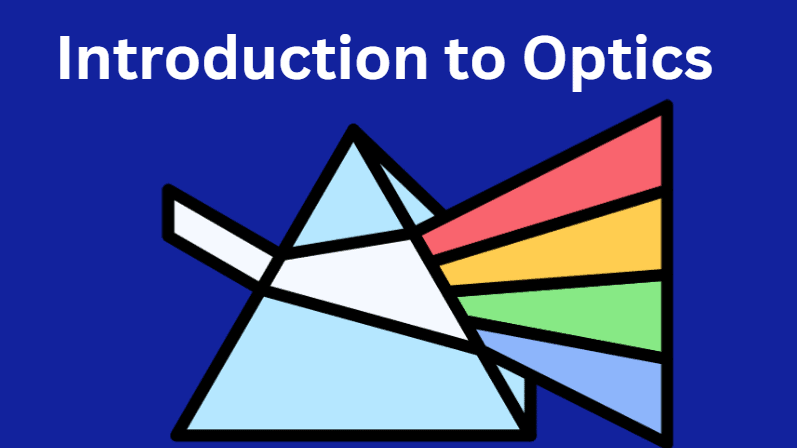Physics Exam > Physics Notes > Basic Physics for IIT JAM > Optics: Introduction
Optics: Introduction | Basic Physics for IIT JAM PDF Download

Introduction
- Optics is a well-known area of physics that focuses on how light behaves and its properties.
- It also looks at how light interacts with matter and the tools we use to detect it. Optics covers the behavior of:
visible light
infrared light
ultraviolet light - In science, imaging can be achieved through a system known as an image forming optical system.
- Optics is the study of how light interacts with matter and how we see things.
- We use lasers in delicate surgeries because they allow for precise cuts and minimal damage.
- Fiber optic cables enable us to watch a football match on television by transmitting light signals over long distances.
- Eyeglasses, microscopes, and telescopes help us bend and focus light to improve our vision or see tiny or distant objects clearly.
- Mirrors also play a role in bending light, allowing us to see reflections or direct light in certain ways.
This article will explore the idea of optics in a clear and organized way.
Light and Its Optical Concepts
- Reflection: This is a key property of light. It is how we see images in mirrors. Reflection happens when light changes direction at the boundary between two different materials and then returns into the same material it came from. Examples of reflection include light bouncing off mirrors, as well as similar processes in sound and water waves.
- Speed of Light: This refers to how fast light moves through space. The speed varies depending on the medium. For instance, light travels about 30% slower in water compared to a vacuum.
- Refraction: This is the bending of light as it moves from one medium to another. Refraction is important in many tools, such as microscopes, magnifying glasses, and eyeglasses. When light passes through a medium, it causes the electrons to polarize, which slows the light down and changes its direction.
- Total Internal Reflection: When light hits water, some of it reflects while the rest bends. This effect, known as total internal reflection, is responsible for various visual phenomena that we observe in everyday life.
- Dispersion: This property occurs when white light separates into its seven basic colors. This can be seen when light passes through a prism.
- In addition to the concepts mentioned above, other characteristics of light include diffraction and interference.
Categorization of Optics
Geometrical Optics:
- In our everyday life, we notice that light mostly travels in straight lines.
- Earlier researchers in optics used geometry to explain how light behaves.
- They suggested that light moves along rays, which are straight segments in open space.
- However, these rays can change direction when they encounter matter.
- Two important laws are associated with this:
- Law of Reflection
- Law of Refraction
- When light bends, an example is seen when an object is partially submerged in water, making it look bent.
- These laws help us understand how tools like telescopes and microscopes work.
Physical Optics:
- Looking at light again, we see another side of optics.
- The fringe property experiment reveals a small bright spot at the center with rings around it.
- These rings cannot be explained by geometrical optics alone, which leads us to the wave nature of light.
- Physical opticsstudies the wave properties of light and is generally divided into three main areas:
- Interference
- Diffraction
- Polarization
The document Optics: Introduction | Basic Physics for IIT JAM is a part of the Physics Course Basic Physics for IIT JAM.
All you need of Physics at this link: Physics
|
214 videos|156 docs|94 tests
|
FAQs on Optics: Introduction - Basic Physics for IIT JAM
| 1. What is the fundamental principle of optics? |  |
Ans. The fundamental principle of optics is the study of light and its interactions with matter. It encompasses how light is generated, transmitted, and received, focusing on phenomena such as reflection, refraction, diffraction, and interference.
| 2. What are the main types of lenses used in optics? |  |
Ans. The main types of lenses in optics are convex lenses, which converge light rays to a focal point, and concave lenses, which diverge light rays. Convex lenses are used in magnifying glasses and cameras, while concave lenses are found in glasses for nearsightedness.
| 3. How does the lens formula relate to image formation? |  |
Ans. The lens formula, given by 1/f = 1/v + 1/u, relates the focal length (f), the image distance (v), and the object distance (u). It helps determine the position and nature of the image formed by a lens, whether it is real or virtual.
| 4. What is the difference between reflection and refraction? |  |
Ans. Reflection is the bouncing back of light when it hits a surface, while refraction is the bending of light as it passes from one medium to another with a different density. Each phenomenon follows specific laws, such as the law of reflection and Snell's law for refraction.
| 5. What are some practical applications of optics in daily life? |  |
Ans. Optics has numerous practical applications in daily life, including the use of eyeglasses for vision correction, cameras for photography, microscopes for studying small objects, and fiber optics for high-speed data transmission in telecommunications.
Related Searches
















